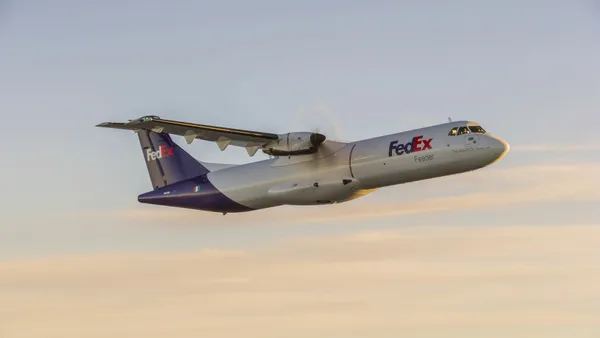Dive Brief:
- Global airfreight volume fell 4.5% YoY in January, but capacity dropped 18% YoY, indicating a greater percentage of available space is being used, according to the latest figures emailed from Clive.
- Clive's dynamic loadfactor, which measures the percentages of cargo space utilized based on volume and weight, was at 66% for January — an increase of nine percentage points YoY.
- Prices have moderated on freight flying from China to the U.S. with rates falling nearly 27% MoM, but high demand relative to capacity means rates are still up more than 58% YoY on the lane to reach $5.78 per kilogram, according to figures from the TAC Index.
Dive Insight:
The drop in airfreight rates out of China are unexpected to some industry onlookers.
"Many assumed there would have been a spike immediately before the Chinese New Year when traditionally factories throughout the country close," Brandon Fried, the executive director of The Airforwarders Association, said in an email.
A granular look at the numbers show that freight demand is picking up heading into Lunar New Year. Rates between Hong Kong and the U.S. are up 17% over the last week.
This highlights an important change in how shippers are buying freight, according to Robert Frei, the business development director at TAC Index.
"If we were not aware of the strong increase in the last week of January, we could possibly assume that, despite the upcoming Chinese New Year, there is a continuing negative trend, but market consensus has it that rate negotiations between shippers, forwarders and carriers are much more short term again (weekly or even per shipment) and, as a result, the number of spot rates has increased drastically compared to previous years. In our numbers we see big spreads," Frei said in a press release.
With a significant number of passenger planes still grounded due to low demand for travel, airfreight continues to largely rely on chartered freighters and all-cargo flights to cover the capacity gap, Fried said.
Niall van de Wouw, the managing director of CLIVE Data Services, said in a statement that some carriers were not able to make capacity commitments for customers in January and February.
"Capacity is tight and we sense no underlying currents which will swiftly change this," van de Wouw said.
Passenger airlines have provided some of this capacity, and they are seeing some financial benefit as a result. United Airlines' cargo revenue was up 77% YoY, according to its most recent earnings; Delta's was up 10% YoY; and American Airlines' was up 32% YoY.
"Despite flying a significantly reduced schedule, in 2020 American operated more than 5,200 cargo-only flights transporting 167 million pounds of critical goods and supplies around the world during the pandemic," American Airlines President Robert Isom said on the company's earnings call last month. "Cargo will continue to be an area of focus in 2021."













